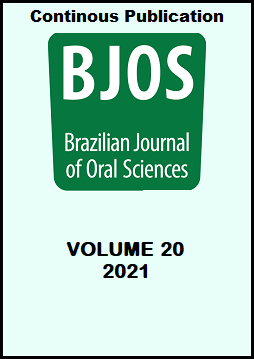Abstract
Minimally invasive dentistry is based on conservative techniques for the treatment of initial caries lesions, the so-called white spot lesions. One of the conservative maneuvers includes the use of enamel resin infiltrant: a low viscosity material that penetrates the enamel pores to stop lesion progression. Aim: Therefore, this case report aimed to describe the clinical case of a 28-year-old female patient under routine consultation, in which a radiographic examination showed the presence of two incipient caries lesions in the left upper premolars. Methods: The application of a resin infiltrating agent (Icon®, DMG – Hamburg, Germany) was chosen as treatment to stop caries lesions progression. Conclusion: The use of this conservative technique can be considered a promising approach for the prevention of dental tissue wear, and the resin infiltrant is considered an effective material.
References
Vanderas AP, Gizani S, Papagiannoulis L. Progression of proximal caries in children with different caries indices: a 4-year radiographic study. Eur Arch Paediatr Dent. 2006 Sep;7(3):148-52. doi: 10.1007/BF03262556.
Vanderas AP, Manetas C, Koulatzidou M PL, Papagiannoulis L. Progression of proximal caries in the mixed dentition: a 4-year prospective study. Pediatr Dent. 2003 May-Jun;25(3):229-34.
Skucha-Nowak M, Gibas M, Tanasiewicz M, Twardawa H, Szklarski T. Natural and controlled demineralization for study purposes in minimally invasive dentistry. Adv Clin Exp Med. 2015;24(5):891-8. doi: 10.17219/acem/28903.
Cury, JA; Tenuta LM. Enamel remineralization: controlling the caries disease or treating early caries lesions? Dental caries: the disease and its signals Enamel remineralization. Braz Oral Res. 2009;23 Suppl 1:23-30. doi: 10.1590/s1806-83242009000500005.
Moreno EC, Zahradnik RT. Demineralization and remineralization of dental enamel. J Dent Res. 1979 Mar;58(Spec Issue B):896-903. doi: 10.1177/00220345790580024301.
Kidd EAM, Fejerskov O. What constitutes dental caries? Histopathology of carious enamel and dentin related to the action of cariogenic biofilms. J Dent Res. 2004;83 Spec No C:C35-8. doi: 10.1177/154405910408301s07.
Ahovuo-Saloranta A, Forss H, Walsh T, Nordblad A, Mäkelä M, Worthington H V. Pit and fissure sealants for preventing dental decay in permanent teeth. Cochrane Database Syst Rev. 2017 Jul;7(7):CD001830. doi: 10.1002/14651858.CD001830.pub5.
Berger S, Goddon I, Chen CM, Senkel H, Hickel R, Stösser L, et al. Are pit and fissure sealants needed in children with a higher caries risk? Clin Oral Investig. 2010 Oct;14(5):613-20. doi: 10.1007/s00784-009-0343-8.
Paris S, Soviero VM, Seddig S, Meyer-Lueckel H. Penetration depths of an infiltrant into proximal caries lesions in primary molars after different application times in vitro. Int J Paediatr Dent. 2012 Sep;22(5):349-55. doi: 10.1111/j.1365-263X.2011.01204.x.
Meyer-Lueckel H, Paris S. Progression of artificial enamel caries lesions after infiltration with experimental light curing resins. Caries Res. 2008;42(2):117-24. doi: 10.1159/000118631.
Paris S, Hopfenmuller W, Meyer-Lueckel H. Resin infiltration of caries lesions: An efficacy randomized trial. J Dent Res. 2010 Aug;89(8):823-6. doi: 10.1177/0022034510369289.
Paris S, Meyer-Lueckel H. Infiltrants inhibit progression of natural caries lesions in vitro. J Dent Res. 2010 Nov;89(11):1276-80. doi: 10.1177/0022034510376040.
Meyer-Lueckel H, Bitter K, Paris S. Randomized Controlled Clinical Trial on Proximal Caries Infiltration: three-Year. Caries Res. 2012;46(6):544-8. doi: 10.1159/000341807.
Vila Verde A, Ramos MMD, Stoneham AM. Benefits in cost and reduced discomfort of new techniques of minimally invasive cavity treatment. J Dent Res. 2009 Apr;88(4):297-9. doi: 10.1177/0022034509334157.
Qvist V. Longevity of restorations: the ‘death spiral’. In: Fejerskov OKE, editor. Dental caries: the disease and its clinical management. 2nd ed. Ox-ford: Blackwell Munksgaard; 2008. p.443-56.
Kidd E. The implications of the new paradigm of dental caries. J Dent. 2011 Dec;39 Suppl 2:S3-8. doi: 10.1016/j.jdent.2011.11.004.
Clark CA, Fintz JB, Taylor R. Effects of the control of plaque on the progression of dental caries: results after 19 months. J Dent Res. 1974;53(6):1468-74. doi: 10.1177/00220345740530062901.
Peters MC. Strategies for noninvasive demineralized tissue repair. Dent Clin North Am. 2010 Jul;54(3):507-25. doi: 10.1016/j.cden.2010.03.005.
Paula ABP, Fernandes AR, Coelho AS, Marto CM, Ferreira MM, Caramelo F, et al. Therapies for white spot lesions—a systematic review. J Evid Based Dent Pract. 2017 Mar;17(1):23-38. doi: 10.1016/j.jebdp.2016.10.003.
Ashwath B, Vijayalakshmi R, Arun D, Kumar V. Site-based plaque removal efficacy of four branded toothbrushes and the effect of dental floss in interproximal plaque removal: a randomized examiner-blind controlled study. Quintessence Int. 2014;45(7):577-84. doi: 10.3290/j.qi.a31960.
Lindhe J, Axelsson P. The effect of controlled oral hygiene and topical Euoride application on caries and gingivitis in Swedish schoolchildren. Community Dent Oral Epidemiol. 1973;1(1):9-16. doi: 10.1111/j.1600-0528.1973.tb01056.x.
Lasfargues JJ, Bonte E, Guerrieri A, Fezzani L. Minimal intervention dentistry: Part 6. Caries inhibition by resin infiltration. Br Dent J. 2013 Jan;214(2):53-9. doi: 10.1038/sj.bdj.2013.54.
Schwendicke F, Meyer-Lueckel H, Stolpe M, Dorfer CE, Paris S. Costs and effectiveness of treatment alternatives for proximal caries lesions. PLoS One. 2014 Jan 27;9(1):e86992. doi: 10.1371/journal.pone.0086992.
Anauate-Netto C, Borelli L Neto, Amore R, DI Hipólito V, D'Alpino PHP. Caries progression in non-cavitated fissures after infiltrant application: a 3-year follow-up of a randomized controlled clinical trial. J Appl Oral Sci. 2017;25(4):442-54. doi: 10.1590/1678-7757-2016-0633.
Saridag S, Helvacioglu-yigit D, Alniacik G, Özcan M. Radiopacity measurements of direct and indirect resin composites at different thicknesses using digital image analysis. Dent Mater J. 2015;34(1):13-8. doi: 10.4012/dmj.2014-181.
Prajapati D, Nayak R, Pai D, Upadhya N, Bhaskar VK, Kamath P. Effect of resin infiltration on artificial caries: an in vitro evaluation of resin penetration and microhardness. Int J Clin Pediatr Dent. 2017 Jul-Sep;10(3):250-6. doi: 10.5005/jp-journals-10005-1445.
Ferreira Zandoná A, Santiago E, Eckert GJ, Katz BP, Pereira de Oliveira S, Capin OR, et al. The natural history of dental caries lesions: a 4-year observational study. J Dent Res. 2012 Sep;91(9):841-6. doi: 10.1177/0022034512455030.

This work is licensed under a Creative Commons Attribution 4.0 International License.
Copyright (c) 2021 Brazilian Journal of Oral Sciences


